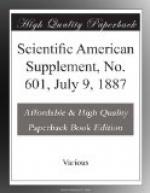Mr. W. Key (Tradeston Gas Works) made a statement giving the results of inquiries he had made at St. Enoch Station Hotel, where the light has for some time been on exhibition. From the answers given to his inquiries he spoke rather disparagingly of the lamp, but chiefly on account of the expense involved in renewing the “mantles” and the glass chimneys. He admitted, however, that the lamps which he had seen were placed very unfavorably, being exposed to the action of somewhat violent draughts, and he subsequently remarked that the lamp was of such a nature as to effect the complete combustion of the carbon contained in the gas. The burner must, therefore, be regarded as a great boon—as the burner, in short.
Mr. D.M. Nelson (Glasgow) gave his experience gained in connection with the light, remarking that one of the great drawbacks to it was the very great rarity of the mineral from which the zirconium was obtained. So scarce was it that it would become dearer than platinum and more valuable than gold if the lamp came into general use. The light which the lamp gave out, though it possessed intensity, was deficient in diffusibility as compared with that given out from ordinary flat flame gas burners, and this was another objection to it. He argued at some length against the financial aspects of the scheme which was being promoted to buy up the Welsbach patents, and to introduce the lamp into this country. His advice to his friends was not to have anything to do with the Welsbach company, and, as investors, to be very careful in accepting all the statements made about the light, which he predicted would not be a financial success.
Mr. McCrae was strongly opposed to any discussion being raised in regard to the question being considered in its financial aspects. They, as gas engineers, did not require to trouble themselves with the doings of investors. He regarded the Welsbach burner as an improved appliance for consuming gas. It was an invention which was quite new to him, and as he was not in possession of any facts which would enable him to condemn it, he thought they ought, at least, to give it a fair trial. Referring to the fragile nature of the “mantle,” he remarked that there were minds at work aiming at giving a purer and more brilliant light from gas, and so far he was of opinion that the light before them was a success. His opinion as to the diffusibility of the light emitted from the burner differed from that of Mr. Nelson, as he considered the light possessed that quality in a high degree. He had no doubt that the minds already at work on the incandescent light would seek out means for improving the burner.
* * * * *
To varnish chromos, take equal quantities of linseed oil and oil of turpentine; thicken by exposure to the sun and air until it becomes resinous and half evaporated; then add a portion of melted beeswax. Varnishing pictures should always be performed in fair weather, and out of any current of cold or damp air.




